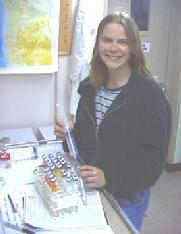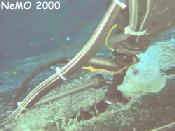| |
Participant
Interview:
Julie Huber
Microbiology Graduate Student
University of Washington
Jeff: This is the third
year of your thesis. Could you discuss what topic you're researching?
Julie: I'm working on projects with Dave Butterfield to understand the
relationship between the chemistry and microbiology (archaea and bacteria)
at diffuse flow vents. We think diffuse vents are an indicator of life
in the subsurface (beneath the ocean crust). Since we don't have good
drilling methods yet, fluids coming out of the sea floor are the only
subsurface expression we have. If the chemistry changes, then we expect
selection for different microbes. In the long run our goal is to map out
what the subsurface at Axial might look like microbially and chemically.
Jeff: What kind of conclusions
can you draw so far?
Julie: We've found that as long as the vent fluids are warmer than background
sea water levels, the hotter the fluids are, the less microbes we find.
I'm using molecular methods to separate out particle-attached (microbes
attached to rock, etc.) vs. free-living (floating in water) populations.
We think that to live in the subsurface its advantageous to make a living
by attaching to particles and forming bio-films (sticking to things by
secreting stuff). Otherwise you're just going to get swept out in rising
vent fluids. I'm working on a '98 and '99 study of partice-attached and
free-living microbes at Marker 33 that's almost done. That will be my
Masters. After that, I'll continue. There's a lot to do out here.
Jeff: What microbes do
you typically find living in the subsurface?
Julie: We usually isolate archaea, which are mostly anaerobic. They probably
come from deep, hot subsurface areas. Every once in a while we get bacteria,
which are mostly aerobic. So, we think that there are oxygenated pockets
(micro-habitats) in the subsurface that have a lot of circulation with
seawater. That's how these micro-habitats are getting their oxygen.
Jeff: What do you find
most exciting about your research?
Julie: I really like playing with the bugs. It's hands-on and I like the
fact that they grow at such high temperatures (sometimes over 100øC).
It's just cool. I mean, we cook the bugs and the bugs just say, "Yea!"
Actually, I think the coolest thing about this is that it's an under-water
volcano. It was so neat the first year we came out here and saw all the
new lava and I was just thinking, Wow, that's not even a year old.
|
|

Julie Huber with tubes full
of "bugs" to "cook"
(read the full story).

Vents Program's fluid sampler at Marker 33 used for collecting many of
the samples for both chemists and biologists.
|
|

